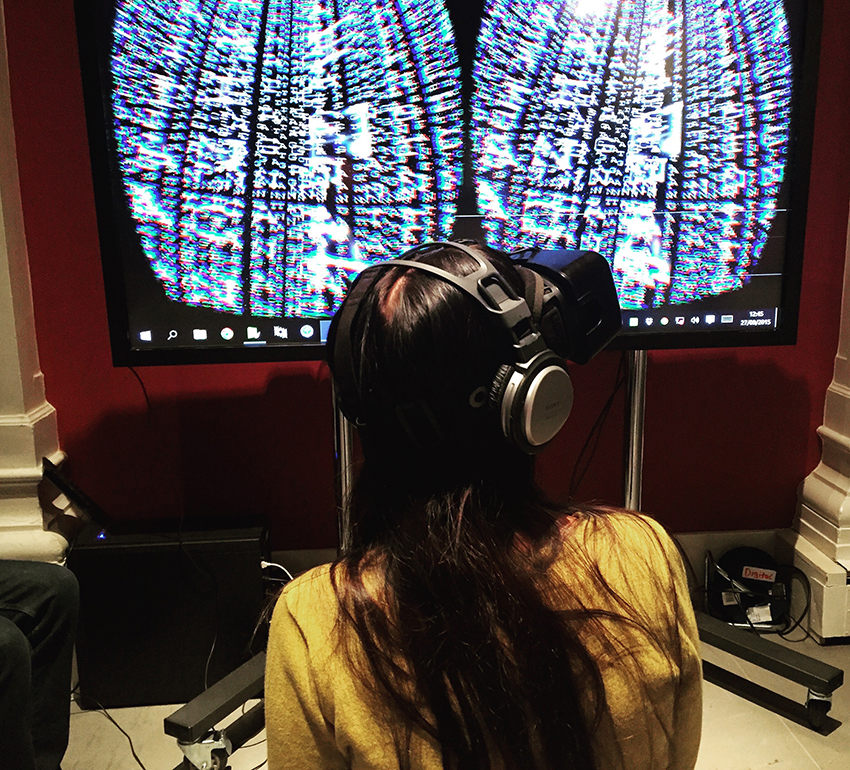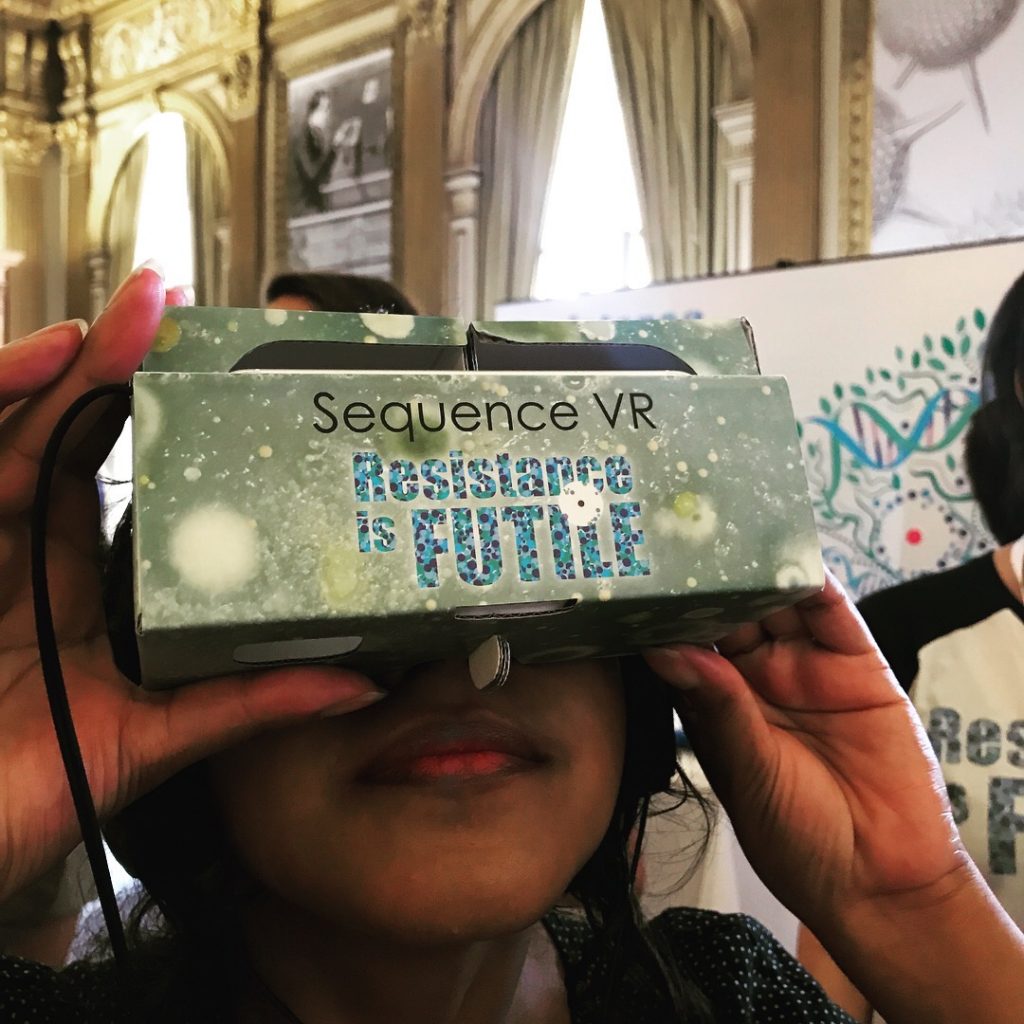The Sequence Project involved the research, development, production and exhibition of a series of artworks fusing leading edge genomics and digital technologies with bacterial BioArt, traditional media and altered historical artefacts, to artistically investigate the emerging technology of whole genome sequencing of bacteria and consider what it means to us personally, culturally and socially.
The project involved in-depth collaborations with microbiologists, bioinformaticians, computer scientists and ethicists from the Modernising Medical Microbiology Project, Public Health England, The University of Oxford, The University of Hertfordshire, Brighton and Sussex Medical School, and artist/programmer Alex May.
The artworks in the series take data from the 2.8 million base pairs of the sequenced DNA of the Staphylococcus aureus bacteria (the non antibiotic resistant form of the MRSA superbug) cultured from Dumitriu’s own body and sequenced by the artist herself, as a starting point to investigate how this new technology operates in both a practical and cultural context, set against a backdrop of public concerns around privacy, the commercialisation of data, the threat of new pandemics and the lack of new antibiotic treatments.
Sequence Dress

The “Sequence Dress” (2015) is 1960 style dress is impregnated with Staphylococcus aureus bacteria and video mapped with raw visual data from the process of whole genome sequencing the strain of the organism that lives on the artist’s own body. The processed and assembled 2.8 million bases of DNA that make up the genome of the bacteria is projected in a halo around the dress. Gaps in the data represent missing or unreadable sections of the genome. The artist sequenced the bacteria as a starting point to investigate how this disruptive technology operates in both a practical and cultural context, set against a backdrop of privacy concerns, commodification of data, the threat of new pandemics, and the lack of new antibiotic treatments. The dress is stained and patterned with the Staphylococcus aureus bacteria from the artists own body, as well as drug resistant strains of MRSA and VRSA grown on dye-containing media, with natural and clinical antimicrobials.
Sequence VR

“Sequence VR” (2015-18) is an immersive virtual reality experience that explores the process of whole genome sequencing of bacteria and enables audiences to experience what Anna Dumitriu has termed the bacterial sublime and learn about how this complex big data process operates and might impact society. Inside the VR headset viewers find themselves surrounded by growing colonies of bacteria from the artists’ skin, then inside a next generation sequencer as they fly through a light field created by fluorescent molecules attaching to millions of DNA bases from a bacterium called Staphylococcus aureus. Then the big data of genetic information rains down around them and finally find yourself inside the resulting vast ring-shaped genome which appears several miles across.

Subsequently the work was developed for a Cardboard VR Smartphone compatible VR viewer created for the “Resistance is Futile” exhibit by Modernising Medical Microbiology from University of Oxford at the Royal Society Summer Science Exhibition 2018. The development was funded by The University of Oxford Knowledge Exchange Seed Fund.
You can view the artwork in full 3D on Youtube using a Cardboard VR Smartphone compatible VR viewer.
Exhibitions and Outcomes
Early outcomes for the “Sequence” project were exhibited as part of The Bacteria Light Lab event at The Wellcome Collection led by Anna Dumitriu as part of the On Light Spectacular . Visitors to the event could meet Dumitriu and her collaborators, including researchers from the Modernising Medical Microbiology Project as well as collaborator artist Alex May, and learn about how light is used in whole genome sequencing of bacteria. The event ran from 1st – 4th May 2015.
Dumitriu also gave an interview for the BBC Radio 4 programme Inside Science presented by Adam Rutherford, with Modernising Medical Microbiology Project researcher Nicola Fawcett.
The “Sequence Dress” premiered at EVA 2015 Conference at the British Computer Society/Computer Arts Society Headquarters in London. That installation also included the a used flow cells (a relic of the process of sequencing the Staphyloccus aureus bacteria DNA from the artist’s body and DIY 3D printed biotech tools.
The Sequence Dress was exhibited as part of “Data Body as Artifact” as part of the ISMAR 2015 (the 14th IEEE International Symposium on Mixed and Augmented Reality) from September 29th – October 4th 2015 at Fukuoka City Museum, Fukuoka, Japan.
An immersive experience “Sequence VR” was shown at The V & A Museum in London as part of the London Design Festival’s Digital Design Weekend 25th-27th September 2015, accompanied by a DNA Extraction and Preparation workshop, where Dumitriu was joined by Dr Nicola Fawcett of the Modernising Medical Microbiology Project.
A video three-screen video installation was shown at Watermans Riverside Gallery 3rd-16th November 2015 accompanied by a demonstration of “Sequence VR” 4-6pm on 14th November 2015 as part of the Networked Bodies Symposium where Anna Dumitriu also gave a lecture.
“Sequence VR” was exhibited at The University of Oxford’s Modernising Medical Microbiology Symposium on 14th December 2015. Discussion events have already taken place at Nottingham Trent University, as part of the “Horizon Scanning series, at The University of Hertfordshire as part of their Art Talks series, and at Brighton Science Festival’s Plague! event.
“The Sequence Dress” and other works by Dumitriu were shown as part of “Culture as Medium” curated by Margaret Macdonald at Baltimore Under Ground Science Space (BUGSS) USA from 8th April 2016 to 20th May 2016.
“Sequence VR” was exhibited at the European Digital Festival 2016 at The Egg in Brussels, Belgium on 21st July 2016 Anna Dumitriu also discussed the project in a lecture.
“Sequence VR” was showcased as part of the Modernising Medical Microbiology free public event “Antibiotics, Microbes and DNA” at The John Radcliffe Hospital in Oxford UK on 30th June 2016. Anna Dumitriu also ran a hands on workshop with Dr Nicola Fawcett.
“The Sequence Dress” and “Sequence VR” was shown as part of The Games Europe Plays: – BODY<>TECH at The Stephen Lawrence Gallery in London, the exhibition ran from 7th July – 26th August 2016. There was a colloquium on Thursday 7th July at the University of Greenwich with curator Ghislaine Boddington where Anna Dumitriu and Alex May discussed the Sequence Project.
“Sequence VR” received follow on funding to develop a new version targeted at younger audiences and incorporating software controlled olfactory elements. The new piece was made in collaboration with Alex May, Dr James Price and Dr Nicola Fawcett and funded by the Royal College of Pathologists. The new piece was launched as part of “Yellow Magic” a special event about the story of penicillin and the miracle of antibiotics at Oxford Museum of the History of Science.
“Sequence VR” for SmartPhones was on show at the Royal Society Summer Science Exhibition in London from 2nd to 8th July 2018 as part of the “Resistance is Futile” exhibit by the University of Oxford/Modernising Medical Microbiology.
Supporters
The Sequence Project was instigated through funding by Arts Council England. “Sequence VR” was subsequently developed through funding from the Royal College of Pathologists and The University of Oxford Knowledge Exchange Seed Fund.
